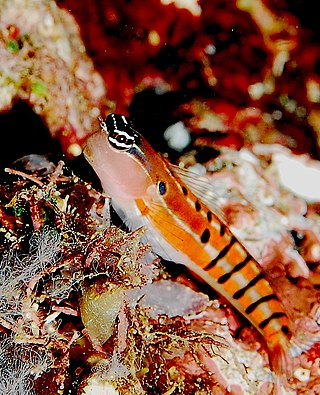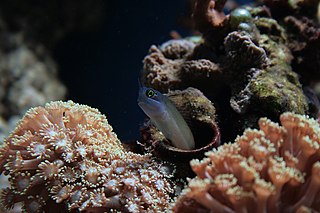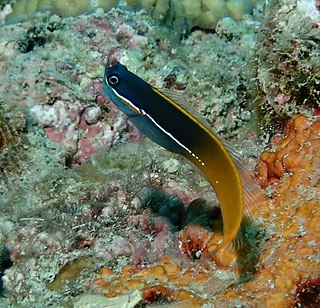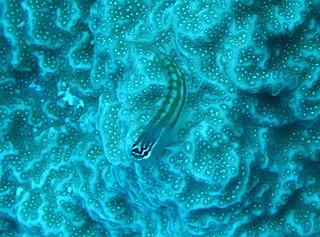
Combtooth blennies are blenniiformids; percomorph marine fish of the family Blenniidae, part of the order Blenniiformes. They are the largest family of blennies with around 401 known species in 58 genera. Combtooth blennies are found in tropical and subtropical waters in the Atlantic, Pacific and Indian Oceans; some species are also found in brackish and even freshwater environments.

Blenny is a common name for many types of fish, including several families of percomorph marine, brackish, and some freshwater fish sharing similar morphology and behaviour. Six families are considered "true blennies", grouped under the order Blenniiformes; its members are referred to as blenniiformids. About 151 genera and nearly 900 species have been described within the order. The order was formerly classified as a suborder of the Perciformes but the 5th Edition of Fishes of the World divided the Perciformes into a number of new orders and the Blenniiformes were placed in the percomorph clade Ovalentaria alongside the such taxa as Cichliformes, Mugiliformes and Gobiesociformes.

Meiacanthus is a genus of combtooth blennies found in the western Pacific and Indian oceans. Many species in this genus make their way into the aquarium trade and several are venomous. The genus name Meiacanthus is derived from the Greek meion meaning "less" and akantha meaning "thorn" and refers to most species having relatively few dorsal fin spines.

Ecsenius axelrodi, known commonly as the Axelrod's clown blenny or the Axelrod's combtooth blenny, is a species of ray-finned fish in the family Blenniidae, the combtooth blennies. It is found in shallow water on coral reefs in the western central Pacific Ocean. It was first described by Victor Gruschka Springer in 1988 and named in honour of the American ichthyologist Herbert Richard Axelrod.
Ecsenius bandanus, known commonly as the Banda comb-tooth, Banda clown blenny, or the Banda combtooth-blenny, is a species of combtooth blenny found in coral reefs in the western Pacific ocean.
Ecsenius caeruliventris, known commonly as the bluebelly blenny in Indonesia, is a species of combtooth blenny in the genus Ecsenius. It is a tropical blenny found in the western Pacific ocean, specifically in Sulawesi, Indonesia. Male Ecsenius caeruliventris can reach a maximum length of 2.4 centimetres, while females can reach a maximum length of 2.37 centimetres; it is one of the smallest blennies in Ecsenius. The species name means "sky-blue belly" from the Latin words caeruleus and ventris, referring to the blue abdomen on the species; the common name is derived from this. The species is most similar to its sister taxon E. shirleyae and E. bandanus.
Ecsenius shirleyae, known commonly as the Shirley's blenny in Indonesia, is a species of combtooth blenny in the genus Ecsenius It is found in the western Pacific ocean, specifically in Indonesia. It can reach a maximum length of 2.8 centimetres. The species was named in honour of Springer's wife, Shirley. It is considered most similar to its sister species E. bimaculatus.
Ecsenius isos is a species of combtooth blenny in the genus Ecsenius. It is found in coral reefs in the western central Pacific ocean, around New Hebrides and New Caledonia. It can reach a maximum length of 3.2 centimetres. Blennies in this species primarily feed off of plants, including benthic algae and weeds. The specific name isos refers to the dark spots beneath the blennies' heads.

Ecsenius melarchus, known commonly as the yellow-eyed comb-tooth or the Java combtooth-blenny in Indonesia, is a species of combtooth blenny in the genus Ecsenius. It is found in coral reefs in the western Pacific ocean. It can reach a maximum length of 5 centimetres. Blennies in this species primarily feed off of plants, including benthic algae and weeds, and are commercial aquarium fish. The specific name "melarchus" is Latin for "black anus", and refers to the black anal marking on the blennies in this species.

Ecsenius pictus, known commonly as the white-lined comb-tooth in Indonesia and the pictus blenny in Micronesia, is a species of combtooth blenny family Blenniidae.

Ecsenius schroederi, known commonly as the Schroeder's combtooth-blenny in Indonesia, is a species of combtooth blenny in the genus Ecsenius. It is found in coral reefs in the western Pacific ocean, specifically in Indonesia. It can reach a maximum length of 7 centimetres. Blennies in this species feed primarily off of plants, including benthic algae and weeds, and are commercial aquarium fish. The species was named in honour of the wildlife artist and scientific illustrator Jack R. Schroeder (1954-2004).
Ecsenius lividanalis, known commonly as the blue-head combtooth-blenny in Indonesia and also known as the blue-headed combtooth blenny, is a species of combtooth blenny in the genus Ecsenius. It is found in coral reefs throughout the western Pacific ocean. It can reach a maximum length of 5 centimetres. Blennies in this species feed primarily off of plants, including benthic algae and weeds, and are commercial aquarium fish. There are two colour forms of this blenny, both of which have a black spot around the anus. One form has a blue head with a yellow body and iris while the other form is dark, occasionally all yellow, with a bluish-white iris, a yellow back and a yellow caudal fin.

Ecsenius mandibularis, also known as the many-toothed blenny, Queensland combtooth blenny or Queensland blenny in Australia, is a species of combtooth blenny in the genus Ecsenius. It is found in coral reefs in the western Pacific ocean, including the southern edge of the Great Barrier Reef. It can reach a maximum length of 7.5 centimetres. Blennies in this species feed primarily off of plants, including benthic algae and weeds.

Ecsenius nalolo, known commonly as the Nalolo in South Africa or the Nalolo blenny in Micronesia, is a species of combtooth blenny in the genus Ecsenius. It is found in coral reefs in the western Indian ocean. It can reach a maximum length of 6.5 centimetres. Blennies in this species feed primarily on plants, including benthic algae and weeds.
Ecsenius oculus, known commonly in Micronesia as the ocular blenny and as the coral blenny on Christmas Island, is a species of combtooth blenny in the genus Ecsenius. It is found in coral reefs in the western Pacific ocean. It can reach a maximum length of 7 centimetres. Blennies in this species feed primarily off of plants, including benthic algae and weeds, and are commercial aquarium fish.

Ecsenius tricolor, known commonly as the Derawan combtooth-blenny in Indonesia, is a species of combtooth blenny in the genus Ecsenius. It is found in the western central Pacific ocean, around the Philippines and Borneo. It can reach a maximum length of 6 centimetres. Blennies in this species feed primarily off of plants, including benthic algae and weeds.

Ecsenius opsifrontalis, known commonly as the comical blenny in Micronesia, is a species of combtooth blenny in the genus Ecsenius. It is found in coral reefs in the Pacific Ocean. It can reach a maximum length of 5 centimetres. Blennies in this species feed primarily off of plants, including benthic algae and weeds, and are commercial aquarium fish.
Ecsenius prooculis is a species of combtooth blenny in the genus Ecsenius. It is found in coral reefs in the western Pacific ocean, around Papua New Guinea and the Solomon Islands. It can reach a maximum length of 3.7 centimetres. Blennies in this species feed primarily off of plants, including benthic algae and weeds.
Ecsenius sellifer, known commonly as the saddle blenny in Guam, or the saddle clown blenny in Micronesia, is a species of combtooth blenny in the genus Ecsenius. It is found in coral reefs in the western Pacific ocean. It can reach a maximum length of 4.1 centimetres. Blennies in this species feed primarily off of plants, including benthic algae and weeds.

Ecsenius trilineatus, known commonly as the three-lined blenny in Australia, and the white-spotted comb-tooth or the white-spotted combtooth blenny in Indonesia, is a species of combtooth blenny in the genus Ecsenius. It is a non-migoratory species of blenny found in coral reefs in the western central Pacific ocean. It can reach a maximum length of 3 centimetres. Blennies in this species feed primarily off of plants, including benthic algae and weeds, and are commercial aquarium fish, but of no interest in fisheries.












